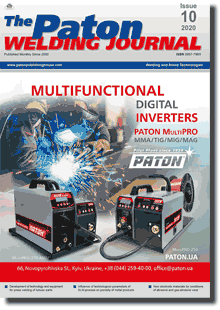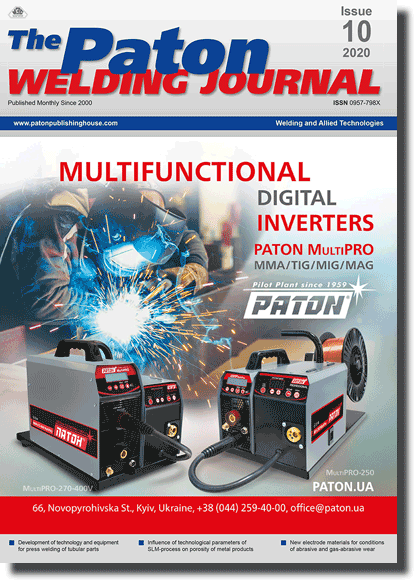| 2020 №10 (02) |
DOI of Article 10.37434/tpwj2020.10.03 |
2020 №10 (04) |

The Paton Welding Journal, 2020, #10, 13-18 pages
Influence of technological parameters of slm-process on porosity of metal products
S.V. Adjamskyi1, G.A. Kononenko2 and R.V. Podolskyi3
1Oles Honchar Dnipro National University 72 Gagarin Prosp., 49000, Dnipro, Ukraine. E-mail: dsit@dnu.edu.ua
2LLC «Additive Laser Technology of Ukraine» 144 Rybin’ska Str., 49000 Dnipro, Ukraine. E-mail: info@alt-print.com
3Z.I. Nekrasov Institute of Iron and Steel of the NAS of Ukraine 1 Academician Starodubov Sq., 49050, Dnipro, Ukraine. E-mail: office.isi@nas.gov.ua
4National Metallurgical Academy of Ukraine 4 Gagarin Prosp., 49000, Dnipro, Ukraine. E-mail: kaf.tom@metal.nmetau.edu.ua
Abstract
Selective laser melting is one of the modern methods of manufacturing parts and assemblies of complex geometry, which are difficult or impossible to reproduce in the conditions of traditional manufacturing. The problem of this manufacturing is that a product quality depends on many factors, which can be divided into such main groups as equipment, material, process, part and finishing. The influence of the specific energy density of scanning the heat-temperature Inconel 718 alloy in the 3D printer Alfa-150 (ALT Ukraine) of the Ukrainian production was investigated. The influence of SLM-technology parameters on the quality of final products is shown and the analysis of the influence of technology factors on the quality of finished products is performed. As a result of metallographic examinations, it was found that the distance between the passes of the laser, at which the estimated overlap of a single track is 25 %, the conditions of deep penetration are created and at the root of the track as a result of collapsing holes (so-called keyhole), large elongated pores are formed. At the estimated overlap of a single track of 17 %, a small number of tiny rounded pores is formed. At the calculated overlap of 0‒8 %, a structure with a minimum number of pores is formed. When the distance between the passes of the laser exceeds the width of a single track at a given combination of power and laser scanning speed, the cases of partial fusion of adjacent tracks are observed, pores with sharp edges are formed, which are stress concentrators — the most dangerous in terms of a product reliability. Thus, a rational overlap of tracks during selective laser melting was established, which ranges from 0 to 8 % of the width of a single track at specific process parameters. 21 Ref., 2 Tables, 4 Figures.
Keywords: selective laser melting, technological factors, quality system, Inconel 718, specific energy density
Received 27.08.2020
References
1. Kruth, J.-P., Leu, M.-C., Nakagawa, T. (1998) Progress in additive manufacturing and rapid prototyping. CIRP Ann.- Manuf. Technol., 47, 2, 525-540. https://doi.org/10.1016/S0007-8506(07)63240-52. Adzhamskij, S.V., Kononenko, A.A., Podolskij, R.V. (2020) Simulation of effect of residual stresses and parameters of SLM technology on formation of boundary product areas from high-temperature nickel alloy Inconel 718. In: Proc. of Int. Sci.- and Techn. Conf. on Information Technologies in Metallurgy and Machine Building (Ukraine, Dnipro, 17-19 March), 4-6. DOI: 10.34185/1991-7848.itmm.2020.01.00. https://doi.org/10.37434/tpwj2020.01.04
3. Mahoney, M.W. (1989) Superplatic Properties of Alloy 718. «Superalloy 718 Metallurgy and Applications». Loria E. A. (eds.), TMS, 391-405. https://doi.org/10.7449/1989/Superalloys_1989_391_405
4. Adzhamskij, S.V., Kononenko, A.A., Podolskij, R.V. (2020) 2D modeling of nonstationary temperature field of unit track from high-temperature nickel alloy Inconel 718. In: Proc. of All- Ukrainian Sci.-Method. Conf. on Problems of Mathematical Modeling, 1, 42-45 [in Ukrainian]. https://www.dstu.dp.ua/uni/downloads/material_konf_traven_%202020.pdf https://doi.org/10.37434/tpwj2020.01.04
5. Shifeng, W., Shuai, L., Qingsong, W. et al. (2014) Effect of molten pool boundaries on the mechanical properties of selective laser melting parts. J. Mater. Process. Technol., 214, 11, 2660-2667 https://doi.org/10.1016/j.jmatprotec.2014.06.002
6. Loh, L.-E., Chua, C.-K., Yeong, W.-Y. et al. (2015) Numerical investigation and an effective modelling on the Selective Laser Melting (SLM) process with aluminium alloy 6061. Int. J. Heat Mass Transf., 80, Jan., 288-300, https://doi.org/10.1016/j.ijheatmasstransfer.2014.09.014
7. Jia, Q., Gu, D. (2014) Selective laser melting additive manufacturing of Inconel 718 superalloy parts: Densification, microstructure and properties. J. Alloys Compd., 585, Feb., 713- 721. https://doi.org/10.1016/j.jallcom.2013.09.171
8. Campanelli S. L., Contuzzi N., Angelastro A.et al. (2010) Capabilities and Performances of the Selective Laser Melting process. New trends in Technologies: Devices, Computer, Communication and Industrial Systems, Nov., 233-252.
9. Williams, C.B., Mistree F., Rosen D. W. (2005) Towards the design of a layerbased additive manufacturing process for the realization of metal parts of designed mesostructured. Proc. 16th Solid Free. Fabr. Symp., pp. 217-230. https://doi.org/10.1115/DETC2005-84832
10. Adzhamskij, S.V., Kononenko, A.A., Podolskij, R.V. (2020) SLM technologies in parts and assemblies of aerospace purpose. In: Proc. of 11th All-Ukrainian Conf. of Young Scientists -2020, 1, 6-9 [in Russian].
11. Adzhamskij, S.V., Kononenko, A.A., Podolskij, R.V. (2020) Study of modes of SLM process on quality in field of product contour. In: Proc. of Int. Conf. on University`s Science 2020. 1, 157-158. http://eir.pstu.edu/bitstream/handle/123456789/17421/%D0%A3%D0%BA%D0%B0%D1%8F%20%D0%BD%D0%B0%D1%83%D0%BA%D0%B0_2020_%D0%A2_1.pdf
12. Adzhamskij, S.V., Kononenko, A.A., Podolskij, R.V. (2020) Development of technology of product manufacturing for aerospace engineering by selective laser melting method. In: Proc. of 12th Int. Sci.-Techn. Conf. on New Materials and Technologies in Mechanical Engineering. https://foundry. kpi.ua/wp-content/uploads/2020/06/conferenziya_2020.pdf#page=29
13. Adzhamskii, S.V., Kononenko, A.A. (2019) Investigation of deep penetration conditions when making samples from high-temperature alloy Inconel 718 by the method of selective laser melting. The Paton Welding J., 6, 54-58. https://doi.org/10.15407/tpwj2019.06.11
14. Adzhamskij, S.V. (2019) Realization of SLM technology for producing of samples from high-temperature nickel alloy Inconel 718, used in aerospace engineering. Aviats.-Kosmich. Tekhnika i Tekhnologiya, 2, 154 [in Russian]. doi:10.32620/aktt.2019.2.09
15. Dilip, J.J.S, Zhang, S., Teng, C. et al. (2017) Influence of processing parameters on the evolution of melt pool, porosity, and microstructures in Ti-6Al-4V alloy parts fabricated by selective laser melting. Progress in Additive Manufacturing, 2, 157-167. https://doi.org/10.1007/s40964-017-0030-2
16. Gu, H., Gong, H., Pal, D. et al (2013) Influences of energy density on porosity and microstructure of selective laser melted 17-4PH stainless steel. Google Scholar.
17. Kasperovich G., Haubrich J., Gussone J., Requena G. (2016) Correlation between porosity and processing parameters in Ti-6Al-4V produced by selective laser melting. Materials & Design, 105, May, 160-170 https://doi.org/10.1016/j.matdes.2016.05.070
18. Pupoa, Y., Delgadoa, J., Serenóa, L., Ciuranaa*, J. (2013) Scanning space analysis in Selective Laser Melting for CoCrMo powder. Procedia Engineering, 63, 370-378. https://doi.org/10.1016/j.proeng.2013.08.228
19. Zhichao, Dong, Yabo, Liu, Weibin, Wen et al. (2019) Effect of Hatch Spacing on Melt Pool and As-built Quality During Selective Laser Melting of Stainless Steel: Modeling and Experimental Approaches. Materials, 12, 1, 50. DOI: 10.3390/ma12010050 https://doi.org/10.3390/ma12010050
20. Yadroitsev, I. et. al. (2007) Strategy of manufacturing components with designed internal structure by selective laser melting of metallic powder. Applied surface Science, 254, 4, p. 980-983. https://doi.org/10.1016/j.apsusc.2007.08.046
21. Adzhams`kij, S.V., Kononenko, G.A. (2020) Regulanities of influence of SLM process parameters on the formation of single layer from the high temperature nickel alloy Inconel 718. The Paton Welding J., 1, 32-38 https://doi.org/10.37434/tpwj2020.01.04
Suggested Citation
S.V. Adjamskyi, G.A. Kononenko and R.V. Podolskyi (2020) Influence of technological parameters of slm-process on porosity of metal products. The Paton Welding J., 10, 13-18.The cost of subscription/purchase order journals or individual articles
| Journal/Currency | Annual Set | 1 issue printed |
1 issue |
one article |
| TPWJ/USD | 384 $ | 32 $ | 26 $ | 13 $ |
| TPWJ/EUR | 348 € | 29 € | 24 € | 12 € |
| TPWJ/UAH | 7200 UAH | 600 UAH | 600 UAH | 280 UAH |
| AS/UAH | 1800 UAH | 300 UAH | 300 UAH | 150 UAH |
| AS/USD | 192 $ | 32 $ | 26 $ | 13 $ |
| AS/EUR | 180 € | 30 € | 25 € | 12 € |
| SEM/UAH | 1200 UAH | 300 UAH | 300 UAH | 150 UAH |
| SEM/USD | 128 $ | 32 $ | 26 $ | 13 $ |
| SEM/EUR | 120 € | 30 € | 25 € | 12 € |
| TDNK/UAH | 1200 UAH | 300 UAH | 300 UAH | 150 UAH |
| TDNK/USD | 128 $ | 32 $ | 26 $ | 13 $ |
| TDNK/EUR | 120 € | 30 € | 25 € | 15 € |
AS = «Automatic Welding» - 6 issues per year;
TPWJ = «PATON WELDING JOURNAL» - 12 issues per year;
SEM = «Electrometallurgy Today» - 4 issues per year;
TDNK = «Technical Diagnostics and Non-Destructive Testing» - 4 issues per year.


